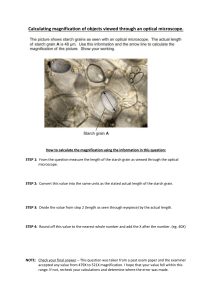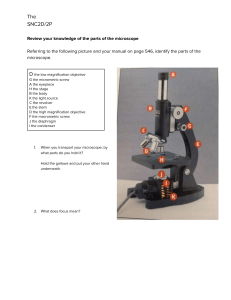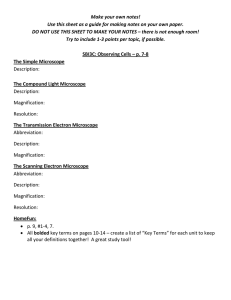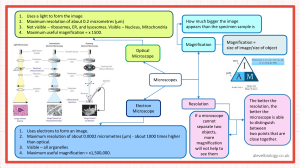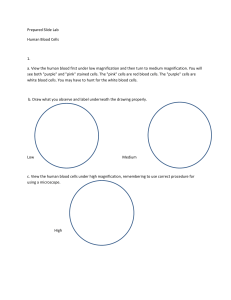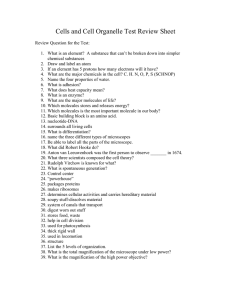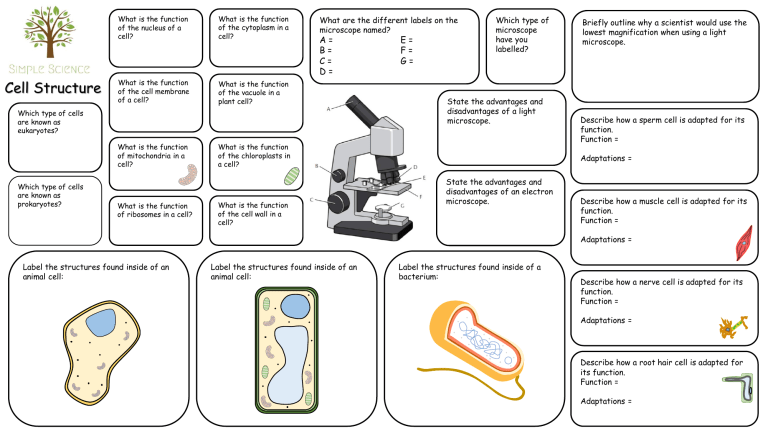
Cell Structure What is the function of the nucleus of a cell? What is the function of the cytoplasm in a cell? What is the function of the cell membrane of a cell? What is the function of the vacuole in a plant cell? What are the different labels on the microscope named? A= B= C= D= Which type of cells are known as eukaryotes? What is the function of mitochondria in a cell? Which type of cells are known as prokaryotes? What is the function of ribosomes in a cell? E= F= G= Which type of microscope have you labelled? State the advantages and disadvantages of a light microscope. What is the function of the chloroplasts in a cell? What is the function of the cell wall in a cell? Briefly outline why a scientist would use the lowest magnification when using a light microscope. Describe how a sperm cell is adapted for its function. Function = Adaptations = State the advantages and disadvantages of an electron microscope. Describe how a muscle cell is adapted for its function. Function = Adaptations = Label the structures found inside of an animal cell: Label the structures found inside of an animal cell: Label the structures found inside of a bacterium: Describe how a nerve cell is adapted for its function. Function = Adaptations = Describe how a root hair cell is adapted for its function. Function = Adaptations = What is meant by the term ‘differentiation’? A scientists is using a light microscope to see an animal cell. The eye piece magnification is 10X and the objective lens is 40X. What is the total magnification? 0.001 = m= 0.0075 = cm = 0.987 = mm = 2.34 = μm = 24.7 = nm = 432.9 = M Km = Ax Convert these numbers to standard form: I= What are the following units? Ac tua Size l Si of ze ima x M ge ag = nif ica tio n Describe the difference between animal and plant cell differentiation in terms of when they can make differentiated cells. The animal cell has been seen using a magnification of 400X. Calculate the actual length of the cell. The animal cell has been seen using a magnification of 200X. Calculate the actual length of the cell. The actual length of this plant cell is 0.003mm. Calculate the magnification used to see the plant cell. Measure the length of the cell. _____mm Measure the length of the cell. _____mm Measure the length of the cell. _____mm Use the magnification equation to calculate the actual length. Use the magnification equation to calculate the actual length. Use the magnification equation to calculate the magnification used. X ______ mm ______ mm Write the magnification equation in the triangle. Describe the size of bacteria compared to eukaryotes. Fill in the missing boxes showing how you would convert between the different units. A cells actual length of 120μm and it has been magnified by 2000X. Calculate the image length of the image produced. ________mm Convert these numbers to 2 decimal places: 324 = 543 = 6543 = 5626 = 5643267 = 8654265 = Convert your answer into standard form. X / X X mm cm m ______X / X nm / μm / ______________ What is the function of the nucleus of a cell? Control the activities of the cell Cell Structure Which type of cells are known as eukaryotes? Animal and Plant Cells Which type of cells are known as prokaryotes? Bacteria What is the function of the cytoplasm in a cell? Where most chemical reactions occur. What is the function of the cell membrane of a cell? Movement of substances that enter and leave. What is the function of the vacuole in a plant cell? Contains cell sap and support the cell. What is the function of mitochondria in a cell? Release energy from respiration. What is the function of the chloroplasts in a cell? Photosynthesis What is the function of ribosomes in a cell? What is the function of the cell wall in a cell? Support and strength Protein Synthesis Label the structures found inside of an animal cell: Cell Membrane Nucleus Ribosome Mitochondria Cytoplasm What are the different labels on the microscope named? A = Eyepiece Lens E = Slide B = Fine Focus F = Stage C = Coarse Focus G = Mirror D = Objective Lens Label the structures found inside of an animal cell: Chloroplast Nucleus Light Microscope State the advantages and disadvantages of a light microscope. + = Cheap - = Low Magnification Low Resolution State the advantages and disadvantages of an electron microscope. + = High Magnification High Resolution - = Expensive Label the structures found inside of a bacterium: Capsule Mitochondria Ribosome Cytoplasm Ribosome Vacuole Cell Wall Cell Membrane Chromosomal DNA Cell Wall Cell Membrane Which type of microscope have you labelled? Flagellum Plasmid Briefly outline why a scientist would use the lowest magnification when using a light microscope. This gives the widest field of view to view much of the cell you are viewing. Describe how a sperm cell is adapted for its function. Function = Fertilise an egg cell Adaptations = Lots of mitochondria to release energy Tail to swim to the egg Enzymes to break to egg surface Describe how a muscle cell is adapted for its function. Function = Contract and relax for movement. Adaptations = Lots of mitochondria to release energy Describe how a nerve cell is adapted for its function. Function = Carry electrical impulses around the body. Adaptations = Long Dendrites that connect to other nerves. Describe how a root hair cell is adapted for its function. Function = Absorb water and mineral ions from the soil. Adaptations = Long provides a large surface area What is meant by the term ‘differentiation’? A scientists is using a light microscope to see an animal cell. The eye piece magnification is 10X and the objective lens is 40X. What is the total magnification? Describe the difference between animal and plant cell differentiation in terms of when they can make differentiated cells. Animal = Early in their life Plants = Throughout their life 0.001 = 1.0x10-3 m = Metres 0.0075 = 7.5x10-3 cm = Centimetres 0.987 = 9.87x10-1 mm = Millimetres 2.34 = 2.34x100 μm =Micrometres 24.7 = 2.47x101 nm = Nanometres 432.9 = 4.329x102 A M M Km = Kilometres I Ax Convert these numbers to standard form: 400X I= What are the following units? 10 x 40 = Ac tua Size l Si of ze ima x M ge ag = nif ica tio n Cell differentiating into different cells. The animal cell has been seen using a magnification of 400X. Calculate the actual length of the cell. The animal cell has been seen using a magnification of 200X. Calculate the actual length of the cell. The actual length of this plant cell is 0.003mm. Calculate the magnification used to see the plant cell. Measure the length of the cell. _____mm Measure the length of the cell. _____mm Measure the length of the cell. _____mm Use the magnification equation to calculate the actual length. Use the magnification equation to calculate the actual length. Use the magnification equation to calculate the magnification used. X Write the magnification equation in the triangle. Fill in the missing boxes showing how you would convert between the different units. ______ mm ______ mm Describe the size of bacteria compared to eukaryotes. A cells actual length of 120μm and it has been magnified by 2000X. Bacteria are much smaller than both animal and plant cells. Calculate the image length of the image produced. 120/1000 = 0.12mm 0.12 x 2000 = 240 Convert these numbers to 2 decimal places: 324 = 320 543 = 540 6543 = 6500 5626 = 5600 5643267 = 5600000 8654265 = 8600000 Convert your answer into standard form. X100 /100 X1000 X10 mm cm m /10 ______X X1000 nm /1000 μm /1000 2.4x102 240mm

